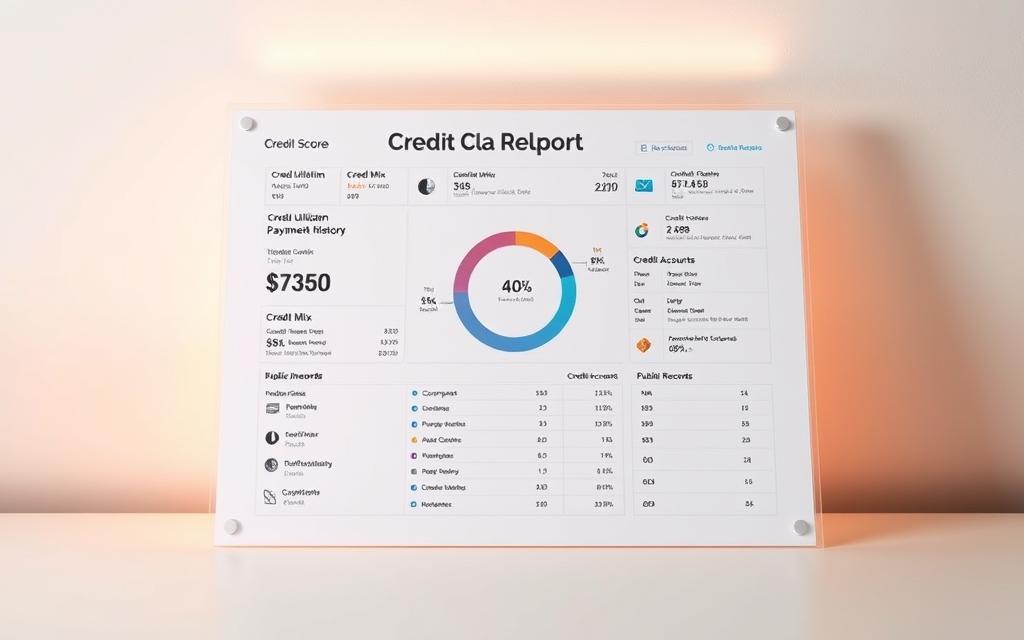About 30% of Americans have a credit score under 601. This shows how crucial it is to understand credit scores now. A credit score isn’t just a number; it’s key for getting loans, credit cards, and leases.
Credit score factors like payment history and debt matter a lot. We’ll look at these factors, bust myths, and give tips to boost your score for better financial chances.
What Is a Credit Score and Why Is It Important?
A credit score shows how reliable you are with money. It’s a number between 300 and 850 that affects your ability to borrow money. Knowing what a good credit score is can help you get better deals.
Definition of Credit Score
Your credit score is based on your past with money. It looks at payments, what you owe, and your account types. A strong score means better loan options.
Factors Influencing Your Credit Score
Several things determine your credit score. Knowing what they are can help you make it better:
| Credit Score Factor | Percentage of Score |
|---|---|
| Payment History | 35% |
| Amounts Owed | 30% |
| Length of Credit History | 15% |
| New Credit | 10% |
| Credit Mix | 10% |
Knowing these factors is key to improving your credit score. Each one affects your score in different ways. This knowledge can guide your efforts to boost your score.
How Credit Scores Are Calculated
Credit scores are vital for showing how trustworthy you are with money. They come from agencies like Equifax, Experian, and TransUnion. These agencies look at your lending history from different places. This info helps show if you’re good at managing your money.
The Role of Credit Bureaus
Credit bureaus have a big job in figuring out credit scores. They put together reports with details from lenders. They look at how you pay bills, how much you owe, and how long you’ve had credit. They also see if you’ve asked for new credit and what types you have. Understanding this helps check your credit score accurately.
Understanding FICO vs. VantageScore
FICO and VantageScore are well-known for measuring credit. FICO scores go from 300 to 850, with higher scores being better. Most lenders look at FICO to make choices. VantageScore uses the same scale but looks at credit a bit differently. You might see different scores from them because they use their own methods to calculate. Knowing how FICO and VantageScore differ helps you take charge of your credit.
| Scoring Model | Score Range | Common Uses |
|---|---|---|
| FICO | 300 – 850 | Widely used by lenders for mortgages, auto loans, and credit cards |
| VantageScore | 300 – 850 | Used by various lenders but may be less common than FICO |
The Different Ranges of Credit Scores
It’s very important to understand credit score ranges for improving financial health. There are five levels that show how good your credit is. This knowledge is key to figuring out what a good credit score looks like.
| Credit Score Range | Description | Impact on Financial Opportunities |
|---|---|---|
| Poor (300-579) | Significantly below average score. | Higher interest rates; difficulty in obtaining loans. |
| Fair (580-669) | Just below average performance. | Limited access to credit and higher rates. |
| Good (670-739) | Above average, typically acceptable to lenders. | Access to favorable loan terms and lower rates. |
| Very Good (740-799) | Strong credit history; highly regarded by lenders. | Better terms and competitive interest rates. |
| Excellent (800-850) | Outstanding credit record. | Best rates and ease in securing loans. |
What Constitutes a Good Credit Score?
A score of 670 or higher is seen as good. This helps people get better loan choices. It also leads to lower interest rates, making big purchases like homes or cars easier.
Impact of Poor Credit Scores
A low credit score brings many problems. It means paying more in interest and trouble getting loans. This can limit what you can do financially, showing why a good credit score matters.
How to Check Your Credit Score
Knowing your credit score is key to good financial health. You can check it through different services. Some are free and others are paid, but they all help you understand how creditworthy you are.
Free vs. Paid Credit Score Services
Places like AnnualCreditReport.com offer a free credit score every year. Credit card companies also let you check your score for free. This makes it easy to keep track of how you’re doing.
Paid options give more detailed advice. They use credit calculators to suggest ways to better your score.
What to Look for in Your Credit Report
It’s important to spot mistakes in your credit report. Errors can lower your score unfairly. Look for wrong names or addresses and incorrect account details.
- Errors in personal information, such as name or address discrepancies.
- Incorrect account details, ensuring that all accounts are accurately represented.
- Outdated items, like closed accounts that still appear open.
Stay alert and fix any errors promptly. This can help keep your credit score up.
The Importance of Credit History
Knowing the value of credit history is key for your financial future. It influences many factors that lenders look at for loans and rates. A good credit history can boost your score, leading to better financial products. Let’s explore the importance of credit history length and the impact of late payments.
How Long Does Credit History Matter?
A long credit history is crucial for a high score. Lenders often want to see at least three years of history. The longer your history, the better lenders understand your financial habits. Showing steady payments and responsible credit use helps with loans or credit increases.
The Effects of Late Payments
Late payments can hurt your credit score a lot. They can stay on your report for seven years, affecting loans. Yet, paying on time can improve your score over the years. Good payment history builds trust with lenders, leading to better finance options later.
Common Myths About Credit Scores
Many people have wrong ideas about credit scores, which can hurt their financial health. It’s very important to know these myths. This knowledge helps anyone wanting to better their credit score and steer clear of wrong information.
Myth
There’s a big myth that looking at your credit score can lower it. But that’s not true. Checking your own credit is a soft inquiry, and it doesn’t change your score at all. On the other hand, when lenders check your credit to consider you for a loan, it’s a hard inquiry. This might lower your score a bit.
Many believe that keeping a balance on your credit card boosts your score. This isn’t true either. Paying off your credit card fully each month is better. It helps you dodge interest charges and improves your credit use ratio. Over time, this action helps raise your credit score.
1: Checking My Score Hurts It
Did you know about 34% of Americans think checking their credit score harms it? This belief causes a lot of needless worry. But in truth, looking at your credit score is a soft pull. It doesn’t damage your credit rating.
Keeping an eye on your credit score helps you. You can see improvements, fix mistakes fast, and confidently manage your money.
2: Closing Old Accounts Boosts My Score
About 30% of Americans think that closing old credit accounts will help their credit score. This is a common mistake that can harm your financial health. Keeping old accounts active is key to improving or keeping your credit score good. Closing them affects your credit use and the average age of your accounts, hurting your credit score.
If you want to raise your credit score, know that keeping old accounts open is beneficial. It’s better than thinking closing them will help.
Tips to Improve Your Credit Score
To boost your credit score, focus and consistent actions are key. Concentrate on regular payments and credit use. Getting to know these will guide you on improving your credit score and financial health.
Consistent Payment Habits
Making payments on time is crucial for a better credit score. Late payments can hurt your score for a long time. Use reminders or automatic payments to keep up with due dates. This approach will positively impact your credit history, essential for future loans.
Reducing Credit Utilization
Your credit utilization ratio is important too. It shows how much credit you’re using versus what you have available. Stay under 30% to show you’re good with credit management. Lower your card balances and don’t max out. Keeping an eye on your credit use helps make smart choices for a better score.
| Action | Description | Impact on Credit Score |
|---|---|---|
| Timely Payments | Pay all bills on or before their due dates. | Significantly improves score; demonstrates reliability. |
| Limit Credit Use | Keep credit card balances low relative to limits. | Helps maintain a good credit utilization ratio. |
| Monitor Accounts | Check credit accounts regularly for accuracy. | Identifies discrepancies and prevents misuse. |
How Credit Score Affects Loan Options
A strong credit score can open up many loan options, especially for buying a house or a car. Lenders look at credit scores to decide if lending money is risky. This affects whether you’ll get the loan and your interest rates.
Home Mortgages and Interest Rates
A high credit score makes a big difference when getting a home mortgage. People with great scores get lower interest rates, which means cheaper monthly payments. This can save a lot over the mortgage’s life.
If your score is low, you’ll get higher rates and pay more for a home. Keeping a strong credit score is key for the best mortgage deals.
Auto Loans and Credit Approval
Your credit score is also important for car loans. It helps lenders decide if you can pay back the loan. High scores get you better deals, like lower interest rates and nicer loan conditions.
Low scores may lead to denied loans or higher rates. Knowing how credit scores affect car loans motivates you to manage your money well and pay on time.
| Credit Score Range | Home Mortgage Interest Rate | Auto Loan Terms |
|---|---|---|
| 300 – 579 | 5.5% – 8.0% | 10% – 15% |
| 580 – 669 | 4.0% – 5.5% | 7% – 10% |
| 670 – 739 | 3.5% – 4.0% | 5% – 7% |
| 740 – 850 | 2.5% – 3.5% | 3% – 5% |
In summary, a good credit score leads to better loan offers for both homes and cars. It shows why it’s important to have a good credit record and make payments on time.
Understanding Credit Inquiries
Credit inquiries play a big part in keeping a good credit record. They come in two kinds: hard and soft inquiries. Each affects how lenders see your financial health and credit score.
Hard vs. Soft Inquiries
Hard inquiries happen when a lender looks at your credit to decide on a loan. They can slightly lower your score for a short time. Soft inquiries occur when you or companies check your credit for offers. These don’t affect your score at all.
Impact on Your Score
Knowing the difference between hard and soft inquiries is key. This knowledge helps you take care of your credit. Below is a table showing how they differ:
| Type of Inquiry | Description | Impact on Credit Score |
|---|---|---|
| Hard Inquiry | Occurs during loan applications or when you request credit from lenders. | Can lower your score temporarily. |
| Soft Inquiry | Occurs when checking your own credit or for promotional purposes by companies. | No impact on your score. |
It’s important to understand the effects of these inquiries. Doing so keeps your credit history strong and helps you meet your financial dreams.
The Role of Credit Card Usage
Using credit cards effectively is key to building a good credit score. Knowing how to handle your credit card balances and choosing the right ones are crucial. These actions help keep your finances strong.
Being consistent and responsible with your credit cards can improve your credit score. This leads to better financial health overall.
Benefits of Keeping Balances Low
Keeping credit card balances low has a big benefit. It boosts your credit score. Staying under 30% of your credit limit increases your creditworthiness. It also avoids high interest charges.
This approach helps with better budgeting. You can pay off balances easier and keep a good credit score over time.
Types of Credit Cards to Consider
It’s important to pick the right credit card for your needs. Here are some options:
- Cashback Cards: These give you a percentage back on what you spend, rewarding you for your purchases.
- Travel Rewards Cards: Great for frequent travelers, these cards let you earn points for travel costs.
- Low-Interest Cards: Best for those who might carry a balance, helping to reduce interest costs.
Choosing the right card lets you make the most of its benefits. This can help achieve your financial goals and boost your credit score with smart use.

Resources for Credit Education
Today, knowing about credit scores is crucial for smart choices. Many resources exist to guide you through credit education. They can boost your understanding of money and help you manage your credit better.
Non-Profit Organizations Offering Guidance
Non-profit groups offer free help and information on credit scores. The National Foundation for Credit Counseling (NFCC) and the Consumer Credit Counseling Service (CCCS) provide advice and workshops. Their programs give you strategies for debt management and credit improvement.
Online Tools and Calculators
There are lots of online tools and calculators for credit education. They let you keep an eye on your credit score. You can see how paying off debt or raising your credit limit affects your score. Using these tools helps you work on your credit rating actively.




